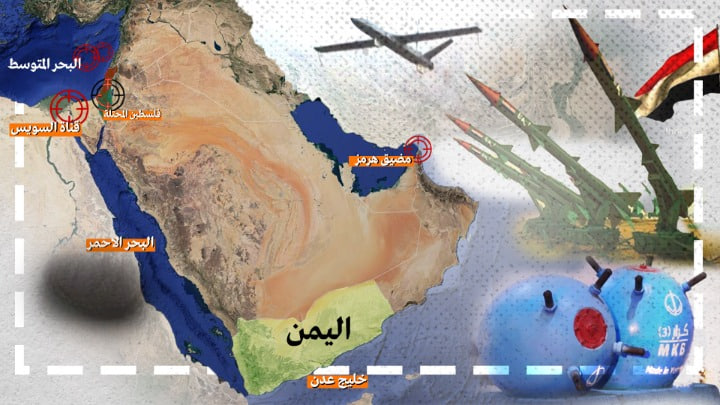The Yemeni Navy: The Shield of September 21 Against Zionist Domination
The September 21, 2014 revolution was not merely a popular uprising against corruption and dependency; it marked the beginning of a new era for Yemen — an era of national sovereignty and the building of an independent state capable of protecting its land, waters, and airspace. One of the most prominent features of this transformation was the rehabilitation of the Yemeni Navy, which had long suffered from marginalization and dismantling during the era of guardianship.
Thanks to this popular revolution led by Commander Abdul Malik Badruddin al-Houthi, the Yemeni army was rebuilt on national foundations, and a determined shift was made toward military manufacturing, especially in the naval sector. Yemen transformed from a besieged state into a deterrent power imposing new equations in the Red Sea and territorial waters, disrupting the calculations of the Zionist enemy and its tools.
From Marginalization to Prestige: The Yemeni Navy After September 21 Revolution
Before the September 21 revolution, the Yemeni Navy barely played a symbolic and limited role due to American conspiracies against state institutions. However, after the revolution, the equation changed drastically. The navy was restructured and unprecedented development projects were launched, from local manufacturing to specialized training, elevating the institution to the ranks of regionally influential naval forces.
Today, the Yemeni naval system is an integral part of the deterrence equation, not only defending the coasts and territorial waters but also deterring Zionist colonial ambitions and imposing new engagement rules in the Red Sea.
Naval Military Manufacturing: From Deficiency to Self-Sufficiency and Threat
Under the leadership of the Commander, the Yemeni military institution witnessed a qualitative renaissance in naval military manufacturing, specifically in the development of:
-
Locally-made precise naval missiles (model):
-
Mandeb 1: A naval cruise missile with high accuracy.
-
Mandeb 2: An improved version with a range exceeding 300 km and significant destructive capability.
-
Falq 1: A naval ballistic missile with a range of over 200 km, designed to strike large naval targets.
-
Rubij B-21 and B-22: Equipped with radar and electro-optical guidance systems, providing Yemen with multi-condition targeting capabilities.
-
-
Offensive unmanned boats:
These have become among the most important naval warfare tools, used to strike ships with high precision and low cost, proving their effectiveness in recent offensive operations. -
Naval drones:
Deployed to monitor hostile movements in open seas and conduct precise strikes on distant targets.
The Commander’s Speech: Defining the National Deterrence Strategy
Commander Abdul Malik Badruddin al-Houthi said in one of his speeches:
“Despite all challenges, we have achieved significant progress in local manufacturing in Yemen… The Yemeni Navy is a living example of what can be accomplished through sincere will. We will not stop building our capabilities until we can protect our country from all external ambitions, especially the Zionist enemy who seeks to interfere in our waters.”
This strategic direction has been the cornerstone in turning the Red Sea into a battleground of resistance, rather than a safe passage for Zionist and American dominance.
The Yemeni Navy at the Heart of Regional Conflict
-
Deterring Zionist ambitions in the Red Sea:
The Zionist enemy sought expansion in the Red Sea through alliances with normalization countries and establishing military-commercial bases and ports. However, after the Yemeni armed forces’ specialized operations, this project is now in jeopardy. -
Breaking the naval blockade:
The naval system did not only deter enemies but played a key role in breaking the economic blockade through maritime pressure and striking ships linked to the Zionist enemy at sea, creating a new naval balance. -
Imposing new engagement rules:
Today, any hostile ship fears passing through the Red Sea without caution due to the Yemeni navy’s surprise strikes, especially with the development of their intelligence and digital capabilities.
Yemen: From Defensive Position to Strategic Offensive Equation
The Yemeni naval forces are no longer confined to defense but have moved to an offensive initiative to support Gaza through:
-
Conducting specialized naval operations against hostile ships.
-
Disrupting Zionist navigation within a calculated deterrent range.
-
Coordinating on the ground with the Palestine front within the framework of the “Promise of the Hereafter” battle, as manifested in naval support operations for Gaza.
Yemen: A Rising Naval Power Against Maritime Colonialism
Thanks to the September 21 revolution and its wise leadership, Yemen was able to restore the prestige of an institution that had been absent for decades. Today, the Yemeni naval system is one of the pillars of regional power confronting the Zionist-American project in the Red Sea.
Yemen today is not merely a coastal state but a formidable barrier against domination—a sovereign naval power that holds the initiative in the nation’s battle against colonialism.

